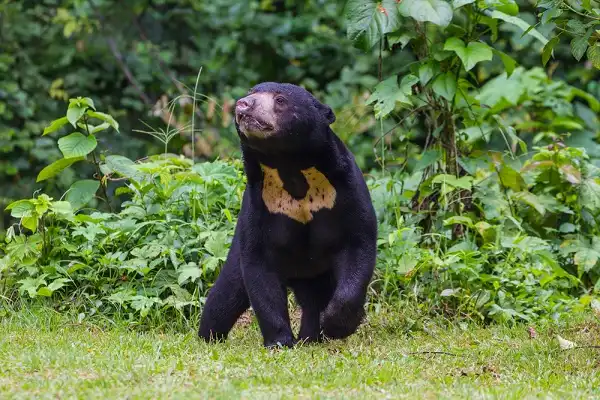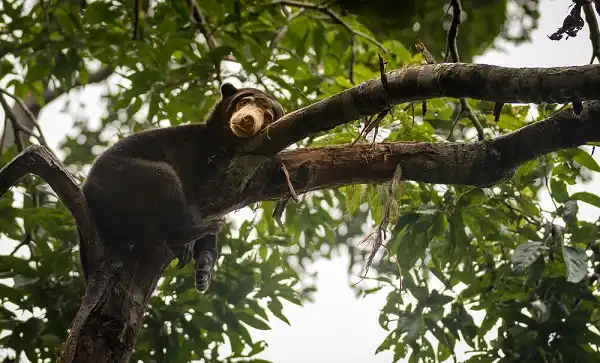The sun bear is the smallest and most vulnerable of the eight bear species in the world. These bears are found in Southeast Asia and can weigh up to sixty-eight kilograms. Despite their size, they are strong climbers and can be very aggressive when threatened. Sun bears have many interesting adaptations, including oily fur that helps them stay cool, and nonretractable claws that help them climb trees. Learn more about these fascinating creatures in this blog post.

Sun Bear Description
Sun bears are the smallest members of the bear family, but they are still formidable predators. They are found in the tropical forests of Southeast Asia, where they primarily eat fruits, insects, and honey. Sun bears are excellent climbers, and they often build nests high up in the trees. They are also adept swimmers, and have been known to dive into rivers to catch fish. Sun bears are protected by law in many countries, but they are still hunted for their body parts, which are used in Traditional Chinese Medicine. As a result of habitat loss and hunting, sun bears are classified as a vulnerable species. Although they may be small, sun bears are powerful animals that play an important role in their ecosystems.
Sun Bear Habitat
Sun bears are found in the tropical forests of Southeast Asia. They typically inhabit lowland forest areas, but can also be found in hills and mountains up to an altitude of 3,000m. Sun bears are mostly active during the day, although they have been known to be active at night on occasion. They are solitary animals, and generally only come together during the mating season. Sun bears are excellent climbers, and spend a lot of their time in trees where they build nests out of leaves and branches. Sun bears are highly arboreal, and are even capable of swimming. Their diet consists mainly of fruits, insects, and honey. Sun bears play an important role in the pollination of many trees and plants, as well as dispersing seeds through their droppings. Deforestation is the biggest threat to sun bear habitat, and these animals are now considered to be endangered.
Sun Bear Diet
Sun bears are the smallest species of bear, and they get their name from the bright yellow or orange crescent-shaped mark on their chest. Sun bears are omnivorous animals, and their diet consists of fruits, insects, and small vertebrates. Sun bears are important seed dispersers in the tropical forests where they live, and they play an important role in the regeneration of these forests. Although sun bears are not currently considered to be endangered, their numbers are declining due to habitat loss and fragmentation. Sun bear populations could be further jeopardized by climate change, as rising temperatures could lead to the loss of their forest habitat.

Sun Bear Size
Sun bears are the smallest species of bear in the world, with adult females weighing in at around 100 pounds and adult males averaging about 150 pounds. Sun bears are found in the tropical forests of Southeast Asia, where they feed primarily on bamboo, berries, and honey. Due to their small size and diet, sun bears do not pose a threat to humans and are not considered dangerous. Sun bears are solitary animals and typically only come together to mate. Females give birth to one or two cubs, which stay with their mother for several years before striking out on their own. Due to habitat loss and poaching, sun bears are classified as vulnerable by the International Union for Conservation of Nature (IUCN). Although steps are being taken to protect sun bears in their natural habitat, more needs to be done to ensure the long-term survival of this unique species.
Sun Bear Lifespan
The sun bear (Ursus helios) is a species of bear found in the tropical forests of Southeast Asia. The sun bear is the smallest species of bear, with an adult weight of only 50-60 kg. Sun bears are mostly active at night, and spend most of their time in trees. They are excellent climbers, and have been known to climb up to 20 m (66 ft) in search of honey or fruits. Sun bears are very good swimmers, and have been known to cross rivers as wide as 4 km (2.5 mi). Sun bears are generally solitary animals, but have been known to form small groups when feeding on large food sources such as fruits or honey bees’ nests. Sun bears typically live for 20-30 years in the wild, though captive sun bears can live for up to 40 years. Sun bear populations are threatened by habitat loss and hunting, and the International Union for Conservation of Nature has classified the sun bear as a “vulnerable” species.

Sun Bear Behavior
Sun bears are the smallest species of bear found in the world. They are also one of the least studied, due in part to their solitary nature and remote habitats. Sun bears are found in the tropical forests of Southeast Asia, where they spend most of their time in trees. They are excellent climbers and often build nests in the forks of branches. Sun bears are mostly active at night, when they search for food. Their diet consists primarily of fruits and insects, although they will also eat small mammals and bird eggs. Sun bears have few predators, but humans represent the biggest threat to their populations. Sun bears are hunted for their body parts, which are used in traditional Asian medicine, and their habitat is being destroyed by logging and agriculture. As a result, sun bears are classified as a vulnerable species by the International Union for Conservation of Nature.
Sun Bear Speed
Sun bears are the smallest member of the bear family, but they certainly don’t lack in speed. These nimble animals can reach speeds of up to 34 miles per hour, making them one of the fastest mammals on four legs. Sun bears are built for speed, with long legs and a sleek, muscular body. They also have powerful hindquarters that they use to propel themselves forward. Sun bears are native to the tropical forests of Asia, where they use their speed to escape from predators and chase down prey. These agile animals are a sight to behold, and their speed is truly impressive.
Sun Bear Hunting
Sun bears are the smallest of the bear family, but what they lack in size they more than make up for in strength and ferocity. Sun bears are native to the tropical forests of Southeast Asia, where they play an important role in the ecosystem. However, sun bear hunting has become a serious problem in recent years. The animals are often killed for their meat and body parts, which are used in traditional medicinal practices. In addition, sun bears are hunted for their gall bladders, which are considered to be a valuable commodity in East Asian markets. As a result of this hunting pressure, sun bear populations have declined sharply in recent years. Sun bear hunting needs to be stopped in order to protect these animals from extinction.

Conclusion
Sun Bear is a fascinating creature that is sadly becoming increasingly rare. By learning more about this animal, we can help to protect it and ensure its survival for years to come. If you’d like to learn more about sun bear conservation or how you can help, please visit the links below. Thanks for reading!
Frequently Asked Question

